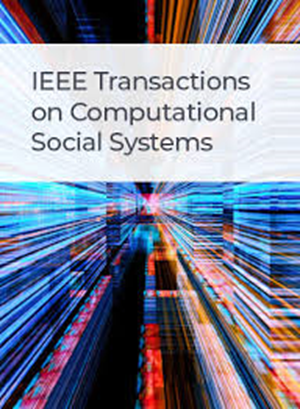用于 COVID-19 模拟的城市轨迹数据驱动方法
IF 4.5
2区 计算机科学
Q1 COMPUTER SCIENCE, CYBERNETICS
IEEE Transactions on Computational Social Systems
Pub Date : 2024-02-02
DOI:10.1109/TCSS.2024.3351886
引用次数: 0
摘要
冠状病毒病 2019(COVID-19)大流行深深改变了世界。无线传感设备采集的城市轨迹大数据为COVID-19的预防提供了巨大帮助。然而,除了接触追踪,轨迹数据很少被应用于其他大流行病的预防场景。在本文中,我们尝试扩展无线传感设备自动收集的轨迹数据的应用范围,并以轨迹数据驱动的方式模拟疫情传播。之后,我们对三种非药物措施的效果进行了量化。与现有研究不同的是,我们的模拟无需复杂的拓扑网络等额外要求,只需通过媒介轨迹的交叉点来推导媒介之间的相互作用。具体来说,首先对病毒在个体间传播的动态进行建模,然后建立一个基于代理的微观模拟环境,作为一个人工系统来进行流行病传播模拟。最后,将轨迹加载到代理中,作为它们相互作用的依据,以自下而上的方式揭示不同干预措施下的宏观变化。作为案例研究,我们根据真实地区的轨迹进行了模拟,结果如下。1) 在三种非药物干预措施中,社区遏制比保持社会距离更有效,与不采取行动相比,社区遏制可将死亡人数降低到近 1/9,而旅行限制的作用有限。2) 人口密度与死亡率之间存在很强的正相关性。3) 由确诊引发的社区遏制时机与死亡人数成正比,因此早期遏制将显著降低死亡率。本文章由计算机程序翻译,如有差异,请以英文原文为准。
An Urban Trajectory Data-Driven Approach for COVID-19 Simulation
The coronavirus disease 2019 (COVID-19) pandemic has changed the world deeply. Urban trajectory big data collected by wireless sensing devices provide great assistance for COVID-19 prevention. However, except for contact tracing, trajectory data are rarely employed in other preventative scenarios against the pandemic. In this article, we try to extend the application of trajectories auto-collected by wireless sensing devices and simulate the epidemic spread in a trajectory data-driven manner. After that, the effects of three nonpharmacological measures are quantified. In contrast to existing studies, additional requirements such as the complex topological networks are needless in our simulation, where the interactions between agents are derived by the intersections of their trajectories. Concretely, the dynamic of virus propagation among individuals is first modeled, and then an agent-based microsimulation environment is built as an artificial system to conduct the epidemic spread simulation. Finally, the trajectories are loaded into the agents as the reliance for their interactions, and the macroscopic changes under different interventions are revealed in a bottom–up way. As a case study, we conduct the simulation based on the trajectories in a real region, in which we find the following. 1) Among the three examined nonpharmacological interventions, community containment is more effective than keeping social distance, which can lower the deaths to nearly 1/9 compared to no action, while travel restrictions play limited roles. 2) There is a strong positive correlation between population densities and mortality. 3) The timing of community containment triggered by confirmed diagnoses is proportional to the number of deaths, thus early containment will significantly decrease mortality.
求助全文
通过发布文献求助,成功后即可免费获取论文全文。
去求助
来源期刊

IEEE Transactions on Computational Social Systems
Social Sciences-Social Sciences (miscellaneous)
CiteScore
10.00
自引率
20.00%
发文量
316
期刊介绍:
IEEE Transactions on Computational Social Systems focuses on such topics as modeling, simulation, analysis and understanding of social systems from the quantitative and/or computational perspective. "Systems" include man-man, man-machine and machine-machine organizations and adversarial situations as well as social media structures and their dynamics. More specifically, the proposed transactions publishes articles on modeling the dynamics of social systems, methodologies for incorporating and representing socio-cultural and behavioral aspects in computational modeling, analysis of social system behavior and structure, and paradigms for social systems modeling and simulation. The journal also features articles on social network dynamics, social intelligence and cognition, social systems design and architectures, socio-cultural modeling and representation, and computational behavior modeling, and their applications.
 求助内容:
求助内容: 应助结果提醒方式:
应助结果提醒方式:


